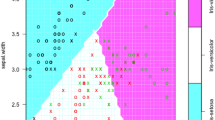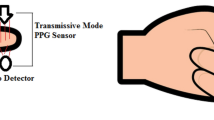Abstract
Type-2 diabetes mellitus (T2DM) is a chronic metabolic disorder affecting numerous people throughout the world. If untreated in the initial stages, diabetes-related complications such as retinopathy, neuropathy, and cardiac issues may arise in the body. This research introduces the efficient automatic T2DM identification method using photoplethysmography (PPG) signals. The tunable-Q wavelet transform (TQWT) is used to analyze the PPG signals which permit the PPG signal to be converted into predictable wavelets. Entropy features are then extracted by these wavelets for events of healthy controls and T2DM followed by statistical significance analysis and classification using least-square support vector machine (LS-SVM) classifier to identify the T2DM events. In addition, the majority voting-based feature selection method is applied for feature reduction and the most relevant feature selection. With top-ranked 20 relevant features, the LS-SVM classifier with radial basis function (RBF) kernel attained a maximum 98.51% classification accuracy, 98.64% sensitivity, 98.38% specificity, 98.61% area under the curve, 98.31% precision, and, 98.47% F-score. The results indicate that the suggested approach for T2DM identification has better classification performance than existing approaches.




Similar content being viewed by others
Data availability and materials
The data used to support the findings of this study are taken from Nirala et al. [8] (https://doi.org/10.1016/j.bbe.2018.09.007). This dataset is not publicly available. The dataset generated during the current study are available from the corresponding author on reasonable request after publication of this article.
References
Himsworth, H.P., Kerr, R.B.: Insulin-sensitive and insulin-insnsitive types of diabetes mellitus. Clin. Sci. 4, 119–152 (1939)
Kopita, L., Kocbek, P., Cilar, L., Sheikh, A., Stiglic, G.: Early detetion of type 2 diabetes mellitus using machine learning-based prediction models. Sci. Rep. 10(1), 1–12 (2020)
Pilt, K., Ferenets, R., Meigas, K., Lindberg, L.G., Temitski, K., Viigimaa, M.: New photoplethysmographic signal analysis algorithm for arterial stiffness estimation. Sci. World J. (2013). https://doi.org/10.1155/2013/169035
Muhammad, I.F., Borné, Y., Östling, G., Kennbäck, C., Gottsäter, M., Persson, M., Engström, G.: Arterial stiffness and incidence of diabetes: a population-based cohort study. Diabetes Care 40(12), 1739–1745 (2017)
Keikhosravi, A., Aghajani, H., Zahedi, E.: Discrimination of bilateral finger photoplethysmogram responses to reactive hyperemia in diabetic and healthy subjects using a differential vascular model framework. Physiol. Measure. 34(5), 513 (2013). https://doi.org/10.1088/0967-3334/34/5/513
Reddy, V.R., Choudhury, A.D., Jayaraman, S., Thokala, N.K., Deshpande, P., Kaliaperumal, V.: PerDMCS: weighted fusion of PPG signal features for robust and efficient diabetes mellitus classification. HEALTHINF (2017). https://doi.org/10.5220/0006297205530560
Qawqzeh, Y.K.: Neural network-based diabetic type II high-risk prediction using photoplethysmogram waveform analysis. Int. J. Adv. Comput. Sci. Appl. 10(12), 1–5 (2019)
Nirala, N., Periyasamy, R., Singh, B.K., Kumar, A.: Detection of type-2 diabetes using characteristics of toe photoplethysmogram by applying support vector machine. Biocybern. Biomed. Eng. 39(1), 38–51 (2019). https://doi.org/10.1016/j.bbe.2018.09.007
Prabha, A., Yadav, J., Rani, A., Singh, V.: Non-invasive diabetes mellitus detection system using machine learning techniques. In: 2021 11th International Conference on Cloud Computing, Data Science and Engineering (Confluence) (pp. 948–953). IEEE. https://doi.org/10.1109/confluence51648.2021.9377138.
Zhang, G., Mei, Z., Zhang, Y., Ma, X., Lo, B., Chen, D., Zhang, Y.: A non-invasive blood glucose monitoring system based on smartphone PPG signal processing and machine learning. IEEE Trans. Ind. Inform. 16(11), 7209–7218 (2020). https://doi.org/10.1109/TII.2020
Avram, R., Tison, G., Kuhar, P., Marcus, G., Pletcher, M., Olgin, J.E., Aschbacher, K.: Predicting diabetes from PHOTOPLETHYSMOGRAPHY using deep learning. J. Am. Coll. Cardiol. 73(9S2), 16–16 (2019). https://doi.org/10.1016/s0735-1097(19)33778-7
Pachori, R.B., Kumar, M., Avinash, P., Shashank, K., Acharya, U.R.: An improved online paradigm for screening of diabetic patients using RR-interval signals. J. Mech. Med. Biol. 16(01), 1640003 (2016). https://doi.org/10.1142/S0219519416400030
Selesnick, I.W.: Wavelet transform with tunable Q-factor. IEEE Trans. Signal Process. 59(8), 3560–3575 (2011). https://doi.org/10.1109/TSP.2011.2143711
Patidar, S., Pachori, R.B., Garg, N.: Automatic diagnosis of septal defects based on tunable-Q wavelet transform of cardiac sound signals. Expert Syst. Appl. 42(7), 3315–3326 (2015). https://doi.org/10.1016/j.eswa.2014.11.046
Patidar, S., Pachori, R.B., Upadhyay, A., Acharya, U.R.: An integrated alcoholic index using tunable-Q wavelet transform based features extracted from EEG signals for diagnosis of alcoholism. Appl. Soft Comput. 50, 71–78 (2017). https://doi.org/10.1016/j.asoc.2016.11.002
Nishad, A., Pachori, R.B., Acharya, U.R.: Application of TQWT based filter-bank for sleep apnea screening using ECG signals. J. Ambient Intell. Hum. Comput. (2018). https://doi.org/10.1007/s12652-018-0867-3
Sadiq, M.T., Akbari, H., Rehman, A.U., Nishtar, Z., Masood, B., Ghazvini, M., Too, J., Hamedi, N., Kaabar, M.K.: Exploiting feature selection and neural network techniques for identification of focal and nonfocal EEG signals in TQWT domain. J. Healthcare Eng. (2021). https://doi.org/10.1155/2021/6283900
Zarei, A., Asl, B.M.: Automatic detection of obstructive sleep apnea using wavelet transform and entropy-based features from single-lead ECG signal. IEEE J. Biomed. Health Informat. 23(3), 1011–1021 (2018). https://doi.org/10.1109/JBHI.2018.2842919
Chen, W., Wang, Z., Xie, H., Yu, W.: Characterization of surface EMG signal based on fuzzy entropy. IEEE Trans. Neural Syst. Rehabil. Eng. 15(2), 266–272 (2007). https://doi.org/10.1109/TNSRE.2007.897025
Zhao, X., Sun, G.: A multi-class automatic sleep staging method based on photoplethysmography signals. Entropy 23(1), 116 (2021). https://doi.org/10.3390/e23010116
Singh, B.K.: Determining relevant biomarkers for prediction of breast cancer using anthropometric and clinical features: a comparative investigation in machine learning paradigm. Biocybern. Biomed. Eng. 39(2), 393–409 (2019)
Sani M, Norhazman H, Omar H, Zaini N, Ghani S (2014) Support vector machine for classification of stress subjects using EEG signals. In: Proc. IEEE Conf. Syst., Process Control (ICSPC), pp. 127–131
Pelckmans, K., et al.: LS-SVMlab: A MATLAB/C toolbox for least squares support vector machines. Tutorial KULeuven-ESAT Leuven Belgium 142(1–2), 1–2 (2002)
Khandoker, A.H., Lai, D.T., Begg, R.K., Palaniswami, M.: Wavelet-based feature extraction for support vector machines for screening balance impairments in the elderly. IEEE Trans. Neural Syst. Rehabil. Eng. 15(4), 587–597 (2007)
Acknowledgements
The authors would like to thank the National Institute of Technology Raipur, India for providing infrastructure and facilities to carry out this research work.
Funding
This research work has no funding support. It’s part of my PhD.
Author information
Authors and Affiliations
Contributions
All authors contributed to the study's conception and design. Material preparation, data collection, and analysis were performed by Bhanupriya Mishra. Data collection was done by Neelam Shobha Nirala, and Figs. 1, 2, 3 and 4 were prepared by Bikesh Kumar Singh. The first draft of the manuscript was written by Bhanupriya Mishra, and all authors commented on previous versions of the manuscript and approved the final manuscript.
Corresponding author
Ethics declarations
Competing interests
The authors declare no competing interests.
Conflict of interest
The authors state that they have no conflict of interest.
Consent to participate
Informed consent was obtained from all individual participants included in the study.
Ethical approval and informed consent
In this work, the dataset was used from the Institute whose ethical approval had already taken and mentioned in Nirala et. al. [8]. This work approved by Institutional Ethical Committee National Institute of Technology Raipur (Letter No- NITRR/IEC/3/2015).
Additional information
Publisher's Note
Springer Nature remains neutral with regard to jurisdictional claims in published maps and institutional affiliations.
Rights and permissions
Springer Nature or its licensor (e.g. a society or other partner) holds exclusive rights to this article under a publishing agreement with the author(s) or other rightsholder(s); author self-archiving of the accepted manuscript version of this article is solely governed by the terms of such publishing agreement and applicable law.
About this article
Cite this article
Mishra, B., Nirala, N. & Singh, B.K. Photoplethysmography signal-based automated diagnosis of type-2 diabetes using tunable-Q wavelet transform and least-square support vector machine classifier. SIViP 17, 2745–2754 (2023). https://doi.org/10.1007/s11760-023-02491-5
Received:
Revised:
Accepted:
Published:
Issue Date:
DOI: https://doi.org/10.1007/s11760-023-02491-5




